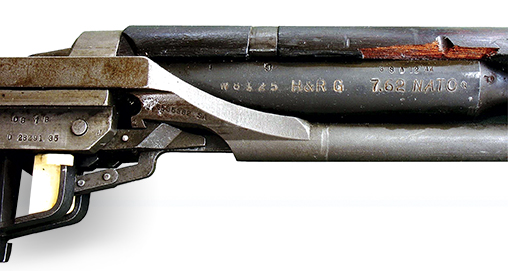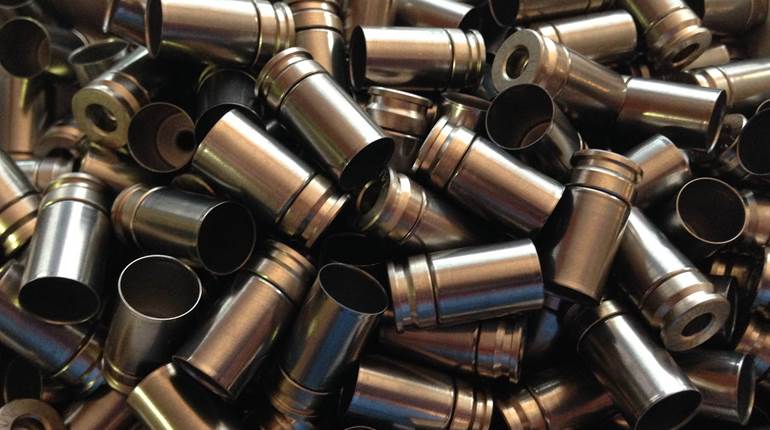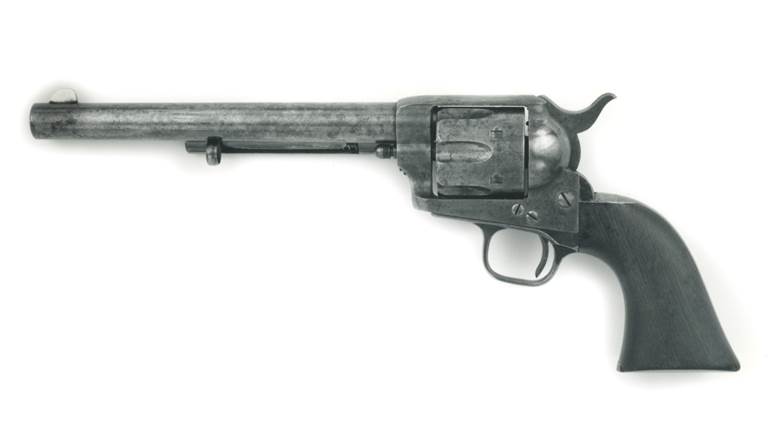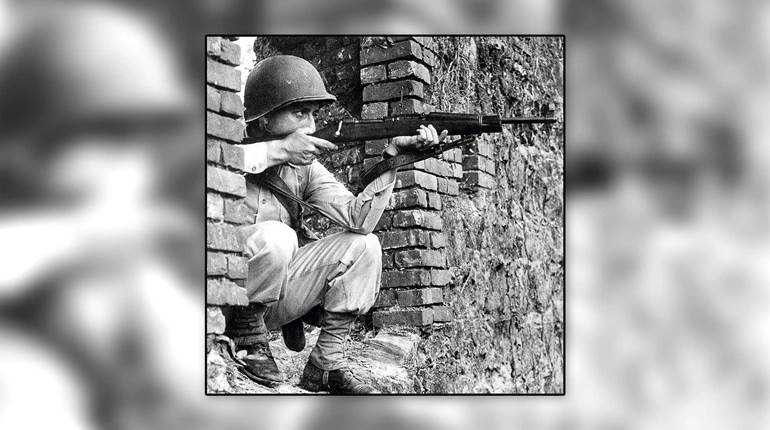
The M14 rifle was officially adopted in 1957 as a replacement for the M1 rifle that had served our armed forces so well for more than 20 years. The adoption of the M14 rifle and the concurrent procurement of the M60 machine gun resulted in the 7.62x51 mm NATO cartridge becoming the standardized cartridge to replace the .30 Springfield (.30-’06 Sprg.). As events transpired, however, due to production delays and glitches encountered with the new M14, it soon became apparent that the Garand’s tenure of service with the U.S. military was far from over. This led to the obvious question of what the Army was going to do with the .30-cal. Garands in its inventory until M14s became available in sufficient numbers.
The U.S. Army Ordnance Dept. evaluated the relative merits of converting the .30-cal. M1s to fire the new 7.62x51 mm NATO cartridge; a concept not without precedent as the Italian military had previously embarked on a program of converting its .30-cal. Garand rifles to 7.62 mm. The rifles were modified for the Italian government by the venerable firm of Beretta. After a great deal of study, the U.S. Army decided against modifying its M1 rifles to chamber the new NATO round. The U.S. Army and Marine Corps were aware that they would be receiving the new M14s as they came on line, and were content to continue using .30-cal. Garands in the interim.
But the U.S. Navy’s need for small arms was very much secondary to those of the Army and Marines, and it was not certain when, or even if, the Navy would be re-equipped with M14s. Small arms were not a major part of the Navy’s inventory, and obtaining the latest service rifles was not considered a matter of great urgency. Nevertheless, while not among its primary armament priorities, rifles were required by the Navy for equipping landing parties, security/sentry personnel, sailors in basic training and competitive shooting teams.
It was believed that the M1s already in inventory would suffice, but it was deemed prudent to have commonality of ammunition with the M14 to mitigate logistical and supply problems. The logical course of action would be to convert the Navy’s Garands to chamber the now-standard 7.62x51 mm NATO cartridge, the Army’s aversion to that course of action notwithstanding.
Plans were made to devise the best method of modifying the Navy’s M1 rifles. In 1959, $25,000 was appropriated for the project to be carried out by the Naval Ordnance Plant in York, Pa., under the direction of James F. Weller. It was soon concluded that the insertion of a metal chamber bushing or sleeve configured to the 7.62 mm cartridge would be the most expedient method of accomplishing the conversion. In 1962, the Navy engaged the services of the H.P. White Laboratories in Street, Md., to develop a satisfactory bushing. In addition to the chamber bushing insert, the gas port of the barrel had to be enlarged to provide sufficient gas for proper rifle functioning. A plastic magazine spacer or block was developed to prevent the accidental loading of the longer .30-’06 Sprg. cartridges into the shorter 7.62x51 mm NATO chamber. The spacer was attached to the M1’s bullet guide. In 1964, Springfield Armory conducted testing on the Navy’s proposed modification of the M1 rifles to 7.62 mm, which were designated “M1E14.”
Preliminary testing at Springfield revealed the barrel chamber bushings tended to become loose and could be ejected-along with the fired cartridge case-at any given time. In an attempt improve the situation, Loktite was applied to the bushing and several rounds subsequently fired to seat it in the chamber. This proved to be only marginally successful. Despite the generally negative conclusions of the Springfield Armory test report, the Navy proceeded with plans to convert many of its .30-’06 Sprg. M1s to 7.62 mm. Although tested by the Army and Marine Corps, with a few exceptions (mentioned below), the .30-’06 Sprg. Garands converted to 7.62 mm were modified under the auspices of the U.S. Navy.
When a Garand was converted to 7.62 mm configuration by the Navy, the rifle was no longer classified as an M1 and was given new nomenclature. As was the Navy’s policy regarding all manner of equipment, not just arms, “MK” (Mark) and “MOD” (Model) numbers were assigned to the converted rifles. For example, the Garand rifles converted to 7.62 mm by means of a barrel bushing were designated as MK 2 – MOD 0” (Mark 2, Model Zero). The later rifles with newly made 7.62 mm barrels installed were the “MK 2 – MOD 1” (Mark 2, Model One).
MK 2 MOD 0 Rifles
The Navy entered into a contract with the American Machine and Foundry (AMF) of York, Pa., to convert rifles to 7.62 mm, and in it these rifles were referred to as “Rifle, M1 Caliber 7.62 mm Conversion.” Once they were converted to 7.62 mm, they lost the M1 nomenclature and were officially MK 2 MOD 0 rifles. The first (approximately) 100 rifles converted were inscribed “7.62 NATO” on the left side of their receivers, but this  designation was soon moved to the right side of the barrel. The initial AMF contract called for 15,050 Garands to be converted, many of which were World War II production rifles. The firm subsequently received another contract to convert an additional 10,000 rifles. In order to augment AMF’s conversion program, the Navy also granted a contract to Harrington & Richardson Arms Co. These rifles were typically stamped “H&R” on the barrel when converted to 7.62 mm.
designation was soon moved to the right side of the barrel. The initial AMF contract called for 15,050 Garands to be converted, many of which were World War II production rifles. The firm subsequently received another contract to convert an additional 10,000 rifles. In order to augment AMF’s conversion program, the Navy also granted a contract to Harrington & Richardson Arms Co. These rifles were typically stamped “H&R” on the barrel when converted to 7.62 mm.
The problem with bushings coming loose and ejecting from the rifle continued to plague the MK 2 MOD 0 Garands. To alleviate the situation, the Naval Weapons Facility at Crane, Ind., proposed cutting grooves in the chamber to better retain the bushing. While an improvement, the grooved chamber did not totally eliminate the problem.
MK 2 MOD 1 Rifles
It eventually became apparent that the best course of action would be to manufacture new barrels chambered for the 7.62 mm cartridge. It would be a relatively simple matter to remove the old .30-’06 Sprg. barrels and install the new 7.62 mm barrels. While more expensive, the new barrels would eliminate the need for the troublesome chamber bushings. Rifles converted by the installation of a new 7.62 mm barrel were designated by the Navy as the “MK 2 MOD 1” (Mark 2, Model One).
Clearly, the purpose-made 7.62 mm barrel was the better choice, and the sensible decision was made to stop using the bushing method and procure new barrels instead. In 1964, the U.S. Navy contracted with Springfield Armory for the manufacture of 30,000 new Garand barrels chambered for the 7.62x51 mm NATO cartridge. The barrels were manufactured in 1965 and 1966. Only about 5,000 of the 17,050 rifles converted by AMF were the later MK 2 MOD 1 variant (fitted with new Springfield 7.62 mm barrels). Of the 15,000 rifles converted by Harrington & Richardson, only some 25 percent were of MK 2 MOD 1 configuration while the rest of the rifles modified by the firm were of the MK 2 MOD 0 (sleeved chamber) variety. As can be seen, MK 2 MOD 0 rifles were fabricated in significantly larger numbers than the later MK2 MOD 1s.
There were three variations of MK 2 MOD 1 rifles. The first was the standard-grade service rifle assigned the Navy stock number 1005-00-923-9070. Other than the 7.62 mm barrel and the white plastic spacer attached to the bullet guide (which required the stock to be slightly routed out on the inside to accommodate the spacer), the rifles were little different from any other post-World War II arsenal-overhauled Garand. A number of them have been awarded as trophy rifles to participants in Navy-sponsored shooting matches. A U.S. Navy manual states that: “Award trophy rifles in the name of the Secretary of the Navy to Naval personnel for superior performance in authorized matches.”
MK 2 MOD 1 Grade “A” Match Rifles
Until 1999, the highest level of trophy rifle typically awarded for Navy matches was the bolt-action .30-’06 Sprg. Remington Model 720 (May 2001, p. 60). A number of these attractive rifles were left over from World War II and were highly prized by the recipients. When the supply of the Model 720 rifles was exhausted, the Navy MK 2 MOD 1 “Grade A” Match rifles were substituted.
The MK 2 MOD 1 rifles accurized by U.S. Navy ordnance facilities for match competition are interesting variations of the genre. When the rifles were “tuned up,” not all of the accurized rifles were of the same quality. Those that proved to have the best accuracy and overall performance were designated as “Mark 2 Mod. 1 Grade A” rifles. The Navy’s method of selecting the different grades began when the rifles were match-conditioned. After being fired for both function and accuracy, they were divided in to “Grade A” and “Grade B” groups based on accuracy specifications. The letter “A” or “B” was stamped on the bottom of each rifle’s pistol grip. On the Grade A rifles, the last four digits of the rifle’s serial number were also often stamped above the letter marking.
The very exacting specifications for the Grade A rifles resulted in precious few reaching that lofty designation. Only about 10 percent of the accurized rifles were of sufficient quality to warrant the Grade A designation, which obviously made that variant the most uncommon of the Navy Trophy rifles. Of the extant match-conditioned rifles on hand when the U.S. Navy enacted serial number control procedures in the early 1970s, it is reported that out of 1,869 rifles accurized by the Navy, only 84 met the stringent Grade A accuracy standards. The remaining 1,785 rifles were relegated to the Grade B category. There is no way to determine how many rifles may have been accurized and subsequently scrapped prior to the institution of the serial number control system by the Navy. In any event, genuine MK 2 MOD 1 Grade A rifles are very uncommon and highly prized arms today.
MK 2 MOD 1 Grade “B” Match Rifles
Even though the MK 2 MOD 1 Grade B rifles didn’t measure up to the exacting standards of the Grade As, they were still very accurate rifles. Other than the letter on the bottom of the pistol grip, the only readily discernable difference between the Grade A and Grade B rifles was the one-minute adjustable rear sights. The Grade B rifles were typically assembled using a variety of parts from different manufacturers and of different vintages. Stocks and handguards could be walnut, birch or a combination. The MK 2 MOD 1 rifles are no longer used by the Navy for competitive shooting as they were superseded by match-conditioned M14 rifles.
Other than the match-conditioned rifles, the Navy apparently made little use of its 7.62 mm Garands. As stated by former Navy officer and 7.62 mm Garand scholar Jim Adell: “I was on active duty from 1963 to 1972 and didn’t see any 7.62 mm M1 rifles except match conditioned ones. While I was never a Weapons Officer on a ship (after a six-month Navy school qualified me to be a Weapons Officer Department Head, Engineering Officer Department Head and an Operations Officer Department Head), I was the person on my ships that conducted small arms training and qualifications. ... [However], a long-time friend (a Quartermaster) said that he remembers his ship had [7.62 mm Garands] … I know that the ships I served on had only cal. .30 M1s.”
Adell also reported that “the only definite use of the 7.62 mm standard grade rifles that has been documented was that about 500 were transferred to the Naval Training Center in San Diego, Calif., to be used to train recruits going through boot camp.”
Colonel Robert H. Rankin, USMC (Ret.) stated in his book, Small Arms of the Sea Services, that some of the converted Garands were issued by the Navy to shipboard guards, sentries and landing parties. However, as confirmed by Adell, other than limited training use, the converted 7.62 mm Garands were utilized by the Navy primarily for match competition and as trophy rifle awards. It should also be remembered that not all of the M1s in the Navy’s inventory were converted to 7.62 mm configuration, and a number of unaltered .30-’06 Garands continued in Naval service until being replaced by M14s and, later, M16s.
In some instances, the Navy’s transition from Garands to the newer rifles did not go as smoothly as might be imagined. As related by Adell: “As a drilling reservist, I spent the last week of August 1973 aboard … the U.S.S. Joseph Hewes (DE 1078) … [and] witnessed the flap of converting from the M1 to the M14. The story was that the Marines were forced to choose the M16 as their weapon and get rid of the M14s. To save the M14s, they were transferred to the Navy. My experience was that the ship (Nuclear capable) had M14s and a magazine full of cal.-.30 ammo but no 7.62 mm ammo. It should be pointed out that the transfer of M14s from the Marine Corps to the Navy was not limited to this one ship, but was universal throughout both branches of the service.”
After the rifles were retired from the Navy’s inventory, the Civilian Marksmanship Program sold a number of MK 2 MOD 0 and MK 2 MOD 1 barreled receivers (not complete rifles) in 2012 and 2013 to qualified civilian purchasers.
Other 7.62 mm Military Match Rifles
While the vast majority of the Garands converted to 7.62 mm under government auspices was done by the U.S. Navy, other branches of the service also fabricated some match rifles chambered for the NATO cartridge. These included the following:
U.S. Air Force Match Rifles
The Air Force built a number of match rifles in both 7.62 mm and .30-’06 Sprg. configuration. They were “worked over” by U.S. Air Force armorers for use in competitive shooting. One of the hallmarks of these arms are the initials AFPG, signifying “Air Force Premium Grade,” stamped on the barrels.
U.S. Marine Corps Match Rifles
The Marines fabricated limited numbers of 7.62 mm Garand match rifles. The modifications performed on these rifles could include the use of NM sights, glass bedding, permanently attaching the lower bands to the front handguards, as well as polishing the barrels and operating rods. Some of the USMC match rifles had all of these modifications done while others had only a few. The unit armorer that performed the match tuning typically had his own ideas on how to modify the rifles, which resulted in a wide variation of features in such rifles.
Secretary Of The Navy Rifles
From the late 1950s well into the 1970s, a number of M1 rifles were given to winners of various military matches, such as the Navy’s East/West Coast Fleet Matches and similar events as trophy rifles. Most of these were not made as, or intended to be, match-grade rifles but were simply given as awards to winners or runners-up of the matches. Some were standard service rifles, and others were rifles that had subsequently been assembled from miscellaneous parts-even some M14 parts that were interchangeable with M1 components.
Even though the M1 rifle’s days were numbered after the adoption of the M14, the old workhorse Garand continued to serve this nation well for a couple more decades. There are many interesting variations of the M1 and the rifles converted to 7.62 mm in the post-war period are among the more interesting and least known examples of the genre. They are further testimony to the genius that went into John Garand’s masterpiece.




































